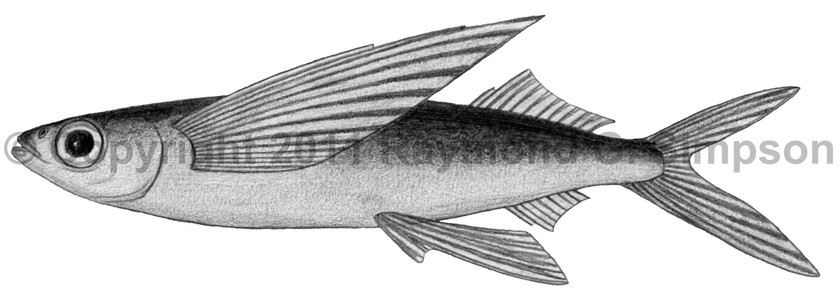
Common Name
Clearwing Flyingfish
Year Described
Mitchill, 1815
Identification
Dorsal Fin: 11-14
Anal Fin: 8-9
Pectoral Fin: 13-15
Gill Rakers: 19-24 (first arch)
Predorsal Scales: 23-30
Transverse Scale Rows: 7-8.5
Vertebrae: 40-43
Body elongate with a rectangular cross-section. Head length 3.8-4.1 in SL. Eye diameter 2.8-3.1 in HL. Jaw teeth conspicuous and tricuspid. Lower jaw slightly shorter than upper. Palatine teeth usually present. Pectoral fins long (1.5-1.6 in SL) with first ray unbranched, fin reaching to caudal fin base. Pelvic fins long (3.3-3.7 in SL), reaching well beyond anal fin origin, with pelvic origin equidistant from caudal base and opercular edge. Dorsal fin low (longest ray more than 10 times in SL). Origin of anal fin well behind that of dorsal fin (under 4-6th dorsal ray). Caudal fin forked with the lower lobe longer than upper. Lateral line low on side. Pectoral branch of lateral line absent. Juveniles with a single thickened, elongate barbel (lost at 15-16cm SL) and expanded pelvic fins.
Color
Body dark blue above, abruptly paler below. Pectoral fin light to medium gray with a thin paler margin. Dorsal and caudal fins gray. Anal fin transparent. Pelvic fin gray basally and transparent distally, rarely with a black spot. Juveniles dark overall with black pelvic fins and a light barbel with dark folds.
Size
Maximum size to 24cm SL.
Habitat
Pelagic in neritic waters. Zooplanktivorous with demersal eggs.
Range
Continental: SE U.S. to the southestern Gulf of Mexico and the Atlantic side of the Caribbean islands to Brazil. Very rare in the Caribbean Sea.
References
Parin, N.V. 2002. Exocoetidae (pp 1116-1134). In: Carpenter. 2002. The living marine resources of the Western Central Atlantic. Vol. 2: Bony fishes part 1 (Acipenseridae-Grammatidae). FAO Species Identification Guides for Fisheries Purposes. American Society of Ichthyologists and Herpetologists Special Publication No. 5.